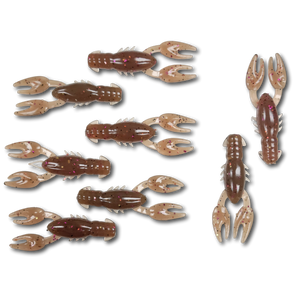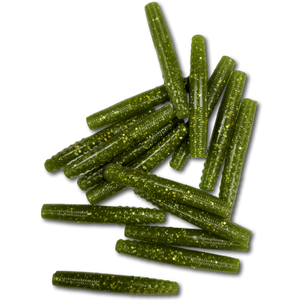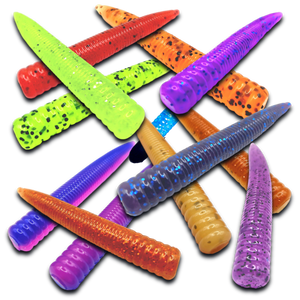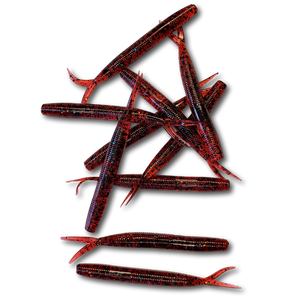Ned baits are small, soft plastics typically paired with light jig heads to create the iconic Ned Rig. Their minimalistic design and subtle action mimic vulnerable prey, such as small baitfish, crawfish, or aquatic insects. This unassuming appearance is what makes them so effective—fish often can’t resist the easy meal.
The hallmark of Ned baits is their buoyant material, which allows them to stand upright on the bottom when rigged properly. This creates a natural and enticing presentation, with the bait’s tail waving gently in the current or with the slightest movement. The result is a versatile bait that excels in a wide range of fishing scenarios.
The Ned Rig is the standard way to fish Ned baits. This setup pairs a small, mushroom-shaped jig head with the bait, creating a presentation that hovers or stands upright on the bottom. Cast it out, let it sink, and use subtle hops, drags, or pauses to trigger strikes. The key is to keep the presentation slow and deliberate, as the bait’s natural action does most of the work.
For deeper water or stronger currents, consider using a slightly heavier jig head to maintain bottom contact. Conversely, in shallow water or when targeting spooky fish, opt for the lightest jig head possible to create a slower fall and more natural movement.
Regardless of the rig, the success of Ned baits lies in their subtlety. Avoid aggressive jerks or fast retrieves—this is a finesse technique that thrives on precision and patience.
Ned baits are effective year-round, making them one of the most versatile tools in an angler’s arsenal.
- Spring: During the spawn, use Ned baits to target bass protecting nests or patrolling shallow flats. The subtle presentation can tempt fish that might ignore larger, more aggressive baits.
- Summer: As temperatures rise and fishing pressure increases, Ned baits excel in clear water or heavily fished lakes. Fish them around docks, grass lines, or rocky points where bass retreat during the heat of the day.
- Fall: Ned baits are perfect for imitating small baitfish as bass feed heavily in preparation for winter. Focus on areas like riprap, shallow flats, and transition zones.
- Winter: When fish are lethargic, Ned baits fished slowly on the bottom can coax bites. This is especially effective in deeper water near ledges, drop-offs, or brush piles.
Geographically, Ned baits perform well in any water body, but they shine in areas with clear water or light fishing pressure. Lakes, rivers, and reservoirs with rocky bottoms, gravel beds, or sparse vegetation are ideal environments for the Ned Rig.
Best Colors and Sizes for Ned Baits
Color selection is crucial when fishing Ned baits. In clear water, natural colors like green pumpkin, watermelon, and brown are the top choices. For stained or murky water, brighter or high-contrast colors like chartreuse, black, or junebug can help fish locate your bait.
Most Ned baits range from 2.5 to 4 inches in length. Smaller baits (2.5-3 inches) are perfect for finesse applications or targeting smaller species like panfish or spotted bass. Larger baits (3.5-4 inches) work well when targeting bigger bass or fishing in slightly stained water.
Why Ned Baits Are So Effective
Ned baits are effective because they trigger both feeding and curiosity strikes. Their compact size and lifelike movement make them look like an easy meal, even for fish that aren’t actively feeding. The buoyant material ensures they stand upright on the bottom, creating a natural presentation that mimics small prey.
Additionally, the simplicity of Ned baits makes them ideal for pressured waters. When fish have seen every other lure in the tackle box, the subtle action and minimalist design of a Ned bait can make all the difference.
Tips for Fishing Ned Baits
When fishing Ned baits, focus on maintaining bottom contact and a slow, methodical presentation. The goal is to mimic a small, vulnerable prey item moving naturally along the bottom. Use a sensitive rod and light line (6-8 lb fluorocarbon) to detect subtle bites.
In windy conditions or strong current, consider using a slightly heavier jig head to keep the bait on the bottom. Conversely, in calm water, a lighter jig head will create a more natural fall.
Experiment with retrieves to match the fish’s mood. Small hops and drags are often effective, but sometimes a simple dead-stick presentation—letting the bait sit motionless—can be just as productive.
Ned baits are a finesse angler’s dream, offering subtle action and versatility that can tempt even the most finicky fish. Whether you’re fishing clear water, pressured lakes, or tough post-front conditions, Ned baits consistently deliver results. Stock up on your favorite colors and sizes, rig them up, and let their understated brilliance do the work for you.
Qwik Catches!













